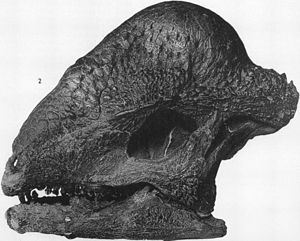Stegoceras
| Stegoceras | ||||||||||||
|---|---|---|---|---|---|---|---|---|---|---|---|---|

Skull of Stegoceras |
||||||||||||
| Temporal occurrence | ||||||||||||
| Upper Cretaceous (late Campanium to Maastrichtian ) | ||||||||||||
| 76.4 to 66 million years | ||||||||||||
| Locations | ||||||||||||
| Systematics | ||||||||||||
|
||||||||||||
| Scientific name | ||||||||||||
| Stegoceras | ||||||||||||
| Lambe , 1902 |
Stegoceras is a genus of the bird pelvic dinosaur (Ornithischia) from the group of the Pachycephalosauria . The two species described are S. validum (Lambe, 1902) and S. edmontonense ( Brown & Schlaikjer , 1943).
features
Stegoceras is one of the best preserved pachycephalosaurs. In addition to a complete skull and dozens of isolated skulls, parts of the body skeleton are also known. This dinosaur was therefore a medium-sized representative of its group and reached 3 meters in length.
As with all pachycephalosaurs, the skull had a thickened roof. The frontal and parietal bones were fused and arched to form the frontoparietal, and the cranial windows in the temporal region were reduced in size. Stegoceras is one of the dome-headed representatives of the Pachycephalosauria. The function of this thickened skull roof is still controversial, it is unclear whether it was used for ramming against the head or torso of the opponent or whether it was only used for display. (See the function of the skull roof in the Pachycephalosauria .) Like all Pachycephalosauria, Stegoceras had different types of teeth ( heterodontics ). On the intermaxillary bone (premaxillary, the foremost part of the upper jaw) there were several pointed, slightly curved teeth, behind which there was a gap known as the diastema . The teeth of the upper jaw (maxilla) were relatively small and had triangular, slightly jagged crowns. The teeth of the lower jaw resembled those of the upper jaw. The structure of the teeth suggests a predominantly plant-based diet, although the function of the different tooth types has not been precisely clarified. They may have added insects to their diet.
The hind legs were significantly longer than the front legs, Stegoceras moved biped (two-legged). The pool was broad as with all Pachycephalosauriern, the tail by ossified tendons stiffened.
Discovery and naming
Stegoceras is one of the earliest known pachycephalosaurs, the genus was described by Lambe in 1902 . Fossil remains have been found in the Canadian province of Alberta and the US state of Montana , there are also remains from New Mexico . The name is derived from the Greek words stegos (= "roof") and keras (= "horn"). Type species is Stegoceras validum .
In 1943 a second species was described with S. edmontonense . Other finds, which were initially also incorporated into Stegoceras , are now considered Ornatotholus , Colepiocephale and Hanssuesia as separate genera, but this is not undisputed. The findings of Stegoceras come from the Upper Cretaceous (late Campanian and Maastrichtian ) and at an age of about 76 bis 66 million years dated .
literature
- Teresa Maryańska , Ralph E. Chapman, David B. Weishampel : Pachycephalosauria. In: David B. Weishampel, Peter Dodson , Halszka Osmólska (eds.): The Dinosauria . 2nd edition. University of California Press, Berkeley CA et al. 2004, ISBN 0-520-24209-2 , pp. 464-477.
- Robert M. Sullivan: A taxonomic review of the Pachycephalosauridae (Dinosauria: Ornithischia). In: Spencer G. Lucas, Robert M. Sullivan (Eds.): Late Cretaceous Vertebrates from the Western Interior (= New Mexico Museum of Natural History and Science. Bulletin. 35, ISSN 1524-4156 ). New Mexico Museum of Natural History and Science, Albuquerque NM 2006, pp. 347–365, digital version (PDF; 4.79 MB) .
Web links
Individual evidence
- ^ Gregory S. Paul : The Princeton Field Guide To Dinosaurs. Princeton University Press, Princeton NJ et al. 2010, p. 242, ISBN 978-0-691-13720-9 , online .